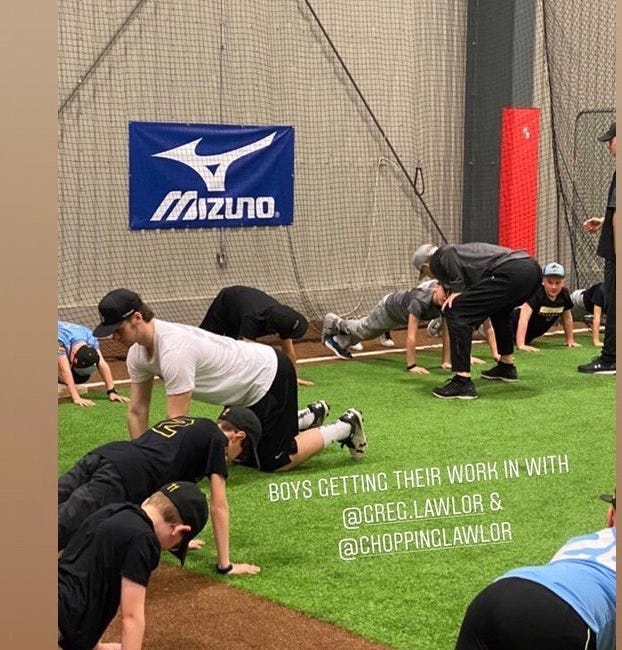#275: College Lacrosse Athletes Hospitalized By Ill-Advised Workout
Sport leaders need to get their head out of sand on the value and structure of appropriate training.
I am passionate about a few things when it comes to youth sport. One of them is physical preparedness for athletes prior to play. From a very young age to the elite levels, athletes must be prepared for the demands of the activity for them to enjoy it. Sport specific skill competency is one thing, but physical literacy and preparedness for the activity is another and the most important foundation for any athlete at any level.
If a young athlete is asked to perform physically without proper ramp up preparation of the body, not only will their performance suffer, but they will get injured.
When a story linking inappropriate training to injury, well it makes my blood boil.
Why?
The damage it does the athletes and the physical harm to them.
That it is totally avoidable.
The avoidable part is so infuriating (can you hear my fingers banging the keys??) because sports leaders (decision makers around sports teams) continue to be ignorant on the value of proper and progressive physical care and preparation of athletes for competition.
The narrative of working athletes hard to build discipline and character often overrule basic physical training principles. We are talking military training vs training for athletics. 2 very different things. Why are there still some who figure that building physical capacity only involves athletes running around at high intensity?
Let’s dig into edition #275 of The Physical Movement.
Have you ever watched lacrosse? Field lacrosse? Seen up close the demands on the body for the athletes that play it?
The physical demands of lacrosse at the college and pro level rank right up there with any other sport. Soccer. Basketball. Hockey. Football. Lots of running. Power, explosiveness, strength, combat, pursuit, changing directions, repeatedly. These sports put the body through a lot.
The athletes that play lacrosse at a high level are some of the most highly conditioned in sport. If they are not, they cannot perform at that level.
When we read that 5 lacrosse players were hospitalized, and 12 injured, we think of food poisoning or some kind of vehicle accident. We don’t think of training so hard it made them sick.
Recently, 12 men’s lacrosse athletes at Tufts University near Boston were diagnosed with rhabdomyolysis (aka rhabdo), a rare injury where your muscle breaks down. Rhabdo is a life-threatening condition that can happen after an injury or excessive exercise without rest. Likely, the workout was too intense for the conditioning level of the athletes. This is especially probable when you consider the athletes are just back after summer break and are not in season in September. Combined with the instructor reportedly being a Navy Seal trained (military style training) guest coach, well, it correlates that too much exercise too intensely caused the problem.
The entire point of a story like this, once we get past the emotion of the needlessness of it, is increasing awareness for the adults’ decision making on what happens during training. An accredited strength and conditioning coach would not ramp up training so much so fast that athletes would be put in harms way.
Assessment, progressions and training different components of preparing the body for competition would be covered. Proper warm up and a workout made up of mobility, power, strength and conditioning drills/exercisers would be programmed with the capacity of the athlete’s current condition in mind. They would not be programmed with the intent to teach how to push through pain, discipline and discomfort as some sort of test of mental fortitude.
The entire concept of coaches and administrators wanting to teach toughness through physical pain is lost on me. I come from a time when conditioning workouts were mandated without access to water. Correct, back in the day that was a thing. Not having access to water during conditioning was supposed to teach us mental toughness as young athletes. No wonder we did not feel so good during and after. How crazy was that?
Obviously, we were not present to view this specific practice at Tufts, however, I do know that asking young athletes to run or do push-ups, burpees or whatever as a form of punishment exists in practices all around us. This is not to say there is not any benefits to pushing our athletes, but rather within the confines of sound physiological principles.
Exercise physiology and progression are not hocus pocus guesswork. It is a science. Real science with real research supporting best practices. Accredited strength and conditioning coaches know about overload and progressions. They take an oath, similar to doctors do, but focused on athlete preparedness and that oath simply states:
“Do no harm”.
Simple, not easy.
How can coaches push athletes in the spirit of wanting to do better without compromising their health? Education + surrounding the team with an experienced strength and conditioning coach.
With that coach in place, with that education part of the program, then those making decisions can be sure the athletes will be safe. This increases the athlete availability to play (reduces injury), improves performance, while developing the skills and experiences we want from youth sports.
Let’s use a story like this to empower decision makers. It starts with parents and families having this discussion and investigating the practices and philosophy of training with coaches and administrators. Let’s not assume that the highest levels know what they are doing. Those making decisions on training men’s lacrosse at Tufts did not.
As the levels of play go up, and the kids get older this can literally become a matter of life and death.
The Physical Movement has a number of resources to assist with education on proper training , as well as how to add qualified personnel to your program. Here are 4:
#234: More Important Than Ever: The Strength and Conditioning Coach.
As we move quickly to 2024, the importance of the strength and conditioning coach for young athletes continues to rise. This article was first published in 2020, and I thought worth updating and sharing again.
The Young Athlete & Strength Training. Trends & Myths. Pros & Cons.
When young Canadian athletes compete the USA during their teenage years, one thing shows up immediately at the highest levels. The American athletes look bigger. They look thicker, especially from 16 years old and on. Regardless of the sport, this shows up repeatedly and reflects the priority placed on preparing the body for the demands of competitio…
#246: The Case For Prioritizing Physical Literacy In Youth Sport.
Recently, in discussion with a local strength and conditioning coach who works with elite athletes, he mentioned the wear and tear he sees. Pro athletes in their early twenties are coming to him in the offseason with knees and hips that function like they are 50 years old. In sports like hockey, the year-round focus on skating without a counter balan…









